Games
PCB
Archive
Chip
Archive
Cart/Box
Scans
Articles
Peripherals
Prototypes
Unreleased
Games
Rarities
Homebrew
Emulation
Email: snes_central@yahoo.ca
Dragon Quest I•IIDragon Quest I•II |
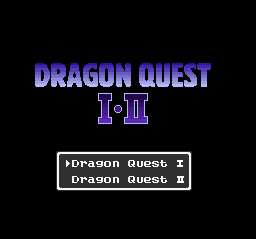 Dragon Quest was one of the first turn based RPGs, and the first popular JRPG released on the Famicom. Due to its popularity, Dragon Quest I•II was released as a combo pack in 1994 for the Super Famicom. By:
Evan G
|
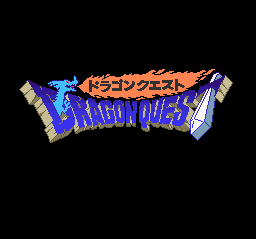
Dragon Quest I•II came out in late 1993 in Japan, much to the delight of Japanese RPG fans who cannot get enough of Dragon Quest. Dragon Quest I•II served as a straight ahead remake of the first two Dragon Quest games, with updated sound, graphics and changes to the amount of gold and experience rewarded to reduce the need for grinding. There is some evidence that Enix may have considered it for an English translation, however it never saw the light of day. RPGOne, a fan translation group led by the late ChrisRPG, completed a fan translation of Dragon Quest I•II in 2003. They included the option of using the patch with Japanese or Dragon Warrior style naming. Another re-release of the Dragon Quest I•II came out on the Game Boy Colour in 2000 in the US (as Dragon Warrior 1&2), with Japanese naming scheme. This review of the SFC version uses RPGOne's translation with Dragon Warrior style naming scheme.
The Story
Dragon Quest I and II are the first two parts of the first Dragon Quest trilogy. Dragon Quest takes place in the kingdom of Alefgard, where you play as the descendent of the great hero, Erdrick. The evil Dragonlord is causing havoc, while at the same time, a dragon kidnaps Princess Gwaelin. In a solo journey, the hero travels throughout Alefgard collecting key items to reach the castle of the Dragonlord, and saving the kingdom.
Dragon Quest II happens 100 years after the first Dragon Quest game. The descendent of the hero from Dragon Quest reside in three kingdoms, eventually joining together to battle the wizard Hargon. The world of Dragon Quest II is far larger than Dragon Quest, and Alefgard makes up only a small part of the map. Due to this, travel gates and a boat allow the heroes to travel the overworld.
Fan service remake or cash in?
Immediately after starting play of this remake, it seems incredibly obvious that little work was done to upgrade this game. Sure the graphics and sound are better than their NES equivalents, but for the most part it is just Dragon Quests I and II using the Dragon Quest V game engine. In fact, it almost looks like they downgraded from the Dragon Quest V engine, and made things look more simplistic (see below). As far as I could tell, there aren't any special bonuses. The enemies in this game are not easier than the NES games, though thankfully they drop more experience points and gold, so grinding is not necessary for the most part. When compared to contemporary turn based RPGs for the Super NES (i.e. Final Fantasy V, Lufia & the Fortress of Doom, and Breath of Fire), these games are dated. Additions such as graphical effects for spells and backgrounds in battle screens seem tacked on. They could not even be bothered to give you the option of town to transport to with the Return spell. This is about as straight forward of a remake as you could get.
Of course, you cannot ignore the popularity of Dragon Quest in Japan. Dragon Quest I•II surely was a huge seller in Japan (reaching #5 in the Japanese charts, according to Super Play), and bridged a gap between the release of V and VI. The success of this game also led to the re-release of Dragon Quest III on the Super Famicom. Considering the dated look and the lack of popularity of RPGs in the US, it is not surprising this game was not ported to the US.
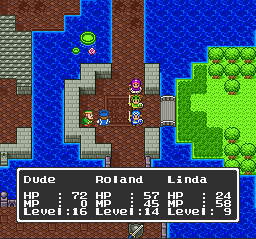 |  |
| Dragon Quest II - in a town | Dragon Quest V - in a town |
 |  |
| Dragon Quest II - world view | Dragon Quest V - world view |
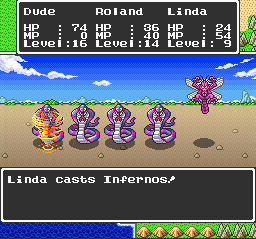 |  |
| Dragon Quest II - battle screen | Dragon Quest V - battle screen (note: all DQV shots are using DeJap and Partial Translations' translation of the SFC game) |
Fan Translation
There are two fan translations of Dragon Quest I•II, though only one is complete. The first attempt was by RPGe, who was responsible for the fan translation of Final Fantasy V. The last patch by RPGe was released in late 1997, and is largely incomplete and buggy. RPGe died in 1999, and the website is gone forever, so we may never know the exact reason why this patch never got closer to completion. Egos and Internet drama are probably well involved, though.
RPGOne completed a translation of Dragon Quest I•II in 2003. I played through both Dragon Quest games using this patch. You can tell a lot of effort was made to make this for both Dragon Quest and Dragon Warrior fans by giving you the option to use Japanese or Dragon Warrior style naming. Dragon Quest fares better than DQII in this patch, and does not have any obvious errors or bugs. Dragon Quest II, on the other hand, has a show-stopping bug that causes the game to glitch when you save the prince from poisoning (see screens below). There are two ways around this: either skip this section by not sleeping at the inn in that town (as the event is optional) or load the game save in the unpatched game, get the prince back and save, then reload the patched version. The consequence is that the prince's name is glitched the rest of the game (my prince was called Rolando, later it changed to just Roland), it causes the prince to reappear in the town he joins your party, and it messes up the weapons store dialogue window so that it doesn't properly refresh when you switch between weapons. This is a pretty major problem, and I do not know why it was missed for this "final" patch. Additionally, when you get to the end of the game, there are many text overflows and spelling/grammar mistakes. Also, there is some lag when the music changes (ie going into battle, entering towns). It seems unfortunate that these issues were never fully addressed. If you can look past these problems, the translation itself is excellent.
One note for those who are playing this game on a flash cart: if you are playing on a CRT TV, the text box at the top of the screen is cut off. The translation hack obviously was done with an emulator in mind and ignored this common problem with older TVs. This is a minor inconvenience and should not affect your experience.
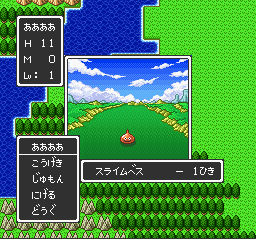 |  |
| Battle from Dragon Quest in the original Japanese release of Dragon Quest I•II | Battle from Dragon Quest in RPGOne translation of Dragon Quest I•II. Note the different placement of the character stats |
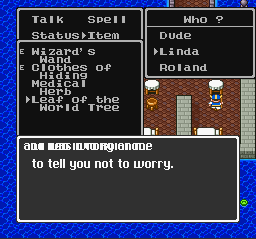 |  |
| Thanks for saving m... aarg garble garble garble | Hey, what is he doing back there! |
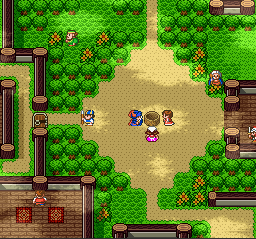 |
| Tree shadows in the village of Kol, perhaps the most impressive looking part of the remake of DQ. |
Comparison of Dragon Quest (SFC) to Dragon Warrior (NES) and Dragon Warrior (GBC)
Dragon Quest originally came out in Japan in 1986. It was released in the US several years later as Dragon Warrior due to a trademark issue with "Dragon Quest". The game was translated and released by Nintendo with disappointing results (they ended up giving away the game to Nintendo Power subscribers to reduce their stocks). The game was quickly overshadowed and outsold by Final Fantasy, which had much deeper gameplay and far better marketing. The lone character, simple graphics and the tedious need for grinding probably scared a lot of people off of the series, which is unfortunate.
The remake resolves the most problematic aspect of Dragon Warrior for the NES: the tedious grinding. Whereas the NES game forced you to do hours of battling to be able to advance through the game, the SFC remake has enemies drop more experience and gold. The end result is that this game can easily be completed in five or six hours if you know where you are going. I recall many hours in the original game fighting the knight where you get Erdrick's armour to get enough experience to tackle the final dungeon. Torches also seem to last a longer period of time in the remake, and show a larger area. The graphics are improved from the NES version, but they certainly don't push the limits of the SNES. In Dragon Quest, the most impressive effects are in the village of Kol, where there are parallax tree shadow effects.
The remake of Dragon Quest makes slight changes to the layouts of the game maps. For example, in Dragon Warrior, when you exit the throne room, the stairs are on the left side of the main corridor. In the remake, they are on the right. The castle and town graphics are greatly improved as well. When it comes down to it, things are generally laid out like the original.
There are obviously some differences in the dialogue. Dragon Warrior was translated by Nintendo, and they threw in many references to "Nester", who was a character created for Nintendo Power. The translation also used old-style English (Thou Thou!) in both the way the characters spoke and the naming for the towns. RPGOne decided to give the option to use the NES naming scheme or the Japanese names. The translation itself is claimed to be far closer to the Japanese version and has more modern English. Depending on your point of view, this could be a good or bad thing. I personally prefer Erdrick over Loto any day, it just sounds more heroic. Certainly the RPGOne translation elaborates more in the text. The only problem I encountered with the RPGOne translation is that they sometimes mixed up east and west for their directions (in particular when you are searching for the token).
As for the GBC version, I quickly played it a bit on an emulator, and it is clearly based off the SFC version, although with simpler 8-bit graphics and sound. Of course, being a handheld game, everything is squished down to a lower resolution. As such, the game map is zoomed in. The translation uses a mixture of Japanese and NES Dragon Warrior names. I do not really have the inclination to go all the way through this, but from the sounds of things this game is not all that different from the SFC release, so it is a matter of preference which you chose to play.
 | 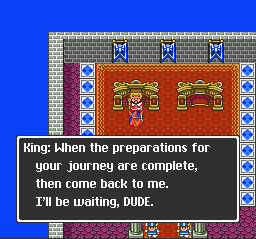 |
| Dialogue in Dragon Warrior for the NES | Same dialogue in the RPGOne translated version of Dragon Quest for the SFC |
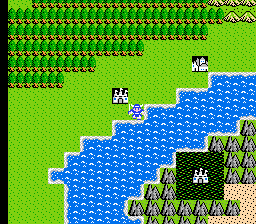 | 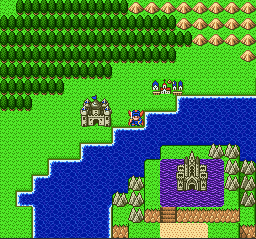 |
| Overworld in Dragon Warrior for the NES | Overworld of Dragon Quest for the SFC |
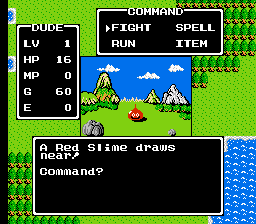 |  |
| Overworld in Dragon Warrior for the NES | Overworld of Dragon Quest for the SFC |
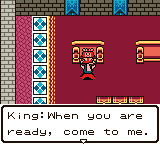 |  |
| Dialogue in Dragon Warrior for the GBC | Same dialogue in the RPGOne translated version of Dragon Quest for the SFC |
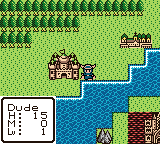 |  |
| Overworld in Dragon Warrior for the GBC | Overworld of Dragon Quest for the SFC |
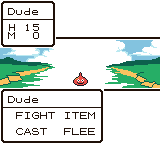 |  |
| Overworld in Dragon Warrior for the GBC | Overworld of Dragon Quest for the SFC |
Comparison of Dragon Quest II (SFC) to Dragon Warrior II (NES) and Dragon Warrior II (GBC)
Dragon Quest II greatly expanded the world containing Alefgard, expanding it by a factor of three or four. It also gave you three characters in your party, each with strengths and weaknesses. The graphics in the NES version improved over the original game, though the bland black background in the battle scenes came to plague the series until it switched to the Super NES. The music is among the best for the NES, though the high pitched squeak when making selections in menus is irritating.
The graphical style in the SFC version is identical to Dragon Quest (they use the same game engine, obviously). Aside from the obvious upgrades in graphics and sound, there are a few cosmetic changes to the game. Like Dragon Quest, they increased the amount of experience and gold that enemies give you to reduce the need for grinding. If an enemy group is defeated before a character attacks, they automatically strike another enemy group. In the NES version, if an enemy group is defeated before another character strikes, their turn is forfeited. The lack of a "door" command was quite an annoyance in DWII, as you had to select the proper key out of your inventory to open a door. In the SFC version, you simply have to press the "X" button to open a door. Another added feature in the SFC version is a bank, where you can store excess items, and protect your gold in case of defeat. Another change is that treasures don't reappear if you re-enter a cave. In the NES game this was necessary, as if you had a full inventory of items and did not pick up a key treasure, you had to exit and re-enter the cave to acquire it. In the SFC version, the treasure is simply returned to the chest. The menu system in the SFC version is also refined to allow you to back out of selections. The SFC version also reduced the cost for some items and sleeping at inns.
As for the translation, there isn't a whole lot of difference between the two games when it comes to conveying meaning. Like Dragon Warrior, the NES Dragon Warrior II is done in an Elizabethan style of English, fitting for the setting of the game. The SFC remake sometimes adds extra NPCs which relay extra information or back-story on the characters. In a way, Dragon Warrior II for the NES has a certain charm to it to make the story seem more like an epic tale. That is not to suggest that RPGOne's fan translation is bad, because it is excellent, but it is a different approach. Really, if one is playing these games simply for the dialogue, it is a matter of preference which to choose.
As for the Game Boy Color remake of Dragon Warrior II, it contains the enhancements of the SFC version, such as the bank and increased gold and experience after battle. However, the downgraded graphics and sound put this between the NES and SFC versions of the game. The layouts of the castles and towns are changed, due to what I suspect is a limitation on the number of sprites that can be displayed on screen. Instead, separate rooms are used to place various NPC characters. The story translation seems to be on par with the other two versions, though they did shorten and change the names of items and weapons. For example, the Wing of Wyvern is simply known as "Wing" in the GBC version. The GBC version adds in some pictorial stills to introduce the story.
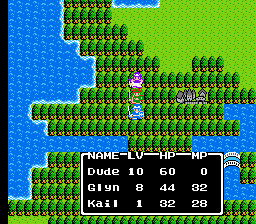 |  |
| Dragon Warrior II - overworld | SFC remake of Dragon Quest II - overworld |
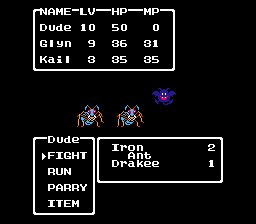 |  |
| Dragon Warrior II - Battle | SFC remake of Dragon Quest II - Battle |
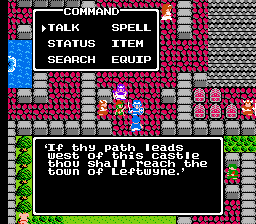 | 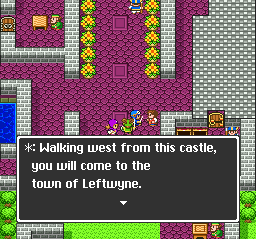 |
| Dragon Warrior II - dialogue | SFC remake of Dragon Quest II - dialogue |
Summary
After playing through Dragon Quest I•II for the SFC and comparing it to the the NES and GBC versions, it is my opinion that it is the definitive versions of these two classic RPGs. Though the graphics and sounds are not vastly superior to the NES versions, the SFC remakes do decrease the need for grinding, which is a common annoyance in RPGs. The translations in all versions are great, and really comes down to stylistic preference. The Game Boy Color version is inferior to the SFC version in terms of graphics, sound and presentation, but is alright for an 8-bit handheld game. About the only thing holding back the RPGOne translated version is a show-stopping bug in Dragon Quest II, which damages an otherwise excellent translation hack.
Bibliography
- Gamepro, Overseas Prospects (preview of the Japanese game - has sevaral screenshots, and amusingly some artwork from Dragon Quest IV; makes no mention of any US release, or that the series is titled Dragon Warrior in the US, for that matter), Publication date: February 1993, Volume: Volume 6, #2 (55), Pages: 183
- Nintendo Power, Pak Watch Update (States that Enix America Corp hadn't decided to translate the game, and they made a plea to write to Enix to bring it out; includes one screenshot; titled Dragon Warrior 1 & 2), Publication date: April 1994, Volume: 59, Pages: 112-113
- Super Play, Super Express - Fantasy Quest (previews of Super Nintendo and Super Famicom RPG games - states it was showin at the Famicom Spaceworld '93 exhibition and was set for a late 1993 release; shows several screenshots that indicate that it would have been nearly finished), Publication date: December 1993, Volume: 14, Pages: 16-17
- Super Play, Super Express - Fantasy Quest (previews of Super Nintendo and Super Famicom RPG games - mentions the game is out in Japan and that Enix planned to translate it for the US market albeit that it would take some time), Publication date: February 1994, Volume: 16, Pages: 14
- Super Play, Super Express - Chart Throb (placed #5 on this month's SFC games list), Publication date: May 1994, Volume: 19, Pages: 23
- Dragon Warrior I&II information on Gamespot (link)
- Incomplete translation of Dragon Quest I•II by RPGe on Romhacking.net (link)
- Completed translation of Dragon Quest I•II by RPGOne on Romhacking.net (link)
- Page on RPGone.net, archived on Archive.org (link)
- Blog post on CinnamonPirate.com about the end of RPGe (link)